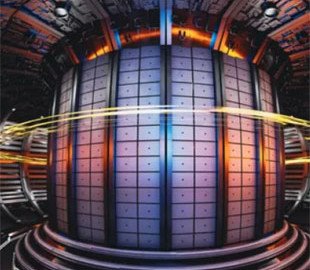New alloy created to strengthen fusion reactors: this is the path to unlimited energy


A new metal alloy withstands high temperatures and prevents corrosion, which will help when starting fusion reactions in tokamaks.
Japanese scientists have created a new alloy with high heat resistance that could solve many problems in fusion reactors, where they will create virtually unlimited energy. In these reactors, conditions can be created like those in the depths of the Sun to produce fusion energy that is clean and virtually unlimited. During the experiment, the new alloy withstood the effects of corrosive coolants used in fusion reactors. These coolants are used because they can help produce more fuel needed by the reactors. The study was published in the journal Corrosion Science, writes Popular Mechanics.
The scientists took an existing heat-resistant alloy from the category of kanthal, which consists of iron, chromium and aluminum. Then they used aluminum oxide to make it stronger and more resistant to high temperatures, as well as corrosion. The oxide dispersion (ODS) alloy was coated with even more aluminum oxide to test the combined thermal stability of the fully assembled material.
The processed alloy withstood turbulent liquid metal at temperatures of 600 degrees Celsius. The scientists also tested the coating for peeling and found that even at high temperatures, it held firmly to the ODS alloy base. According to the scientists, even the bare version of the ODS alloy, without an additional coating of aluminum oxide, spontaneously formed its own outer layer, which they believe contributed to its high heat resistance. Essentially, it did not melt, did not peel, and became stronger.
Why is a temperature of 600 degrees Celsius critical in this case, if the plasma temperature in a fusion reactor must reach millions of degrees Celsius? In this case, the study was devoted to coolers, not to the temperatures that plasma has in a tokamak (a type of fusion reactor).
Scientists use liquid metals, such as an alloy of lithium and lead, to perform two tasks. First, they help start a fusion reaction, which creates more deuterium or tritium, that is, fuel for the reactor. That is, fuel to start a fusion reaction. Deuterium and tritium are isotopes of hydrogen, which is what the Sun uses to create fusion energy. Second, liquid metals act as protective coolants.
As scientists explain, heavy liquid metal coolants, such as lead, lead-bismuth alloy, and lithium-lead alloy, are corrosive fluids, although they have excellent heat-resistant properties. Corrosion — is the process by which even a relatively stable metal seeks out and absorbs oxygen particles and eventually oxidizes, that is, forms oxide sites.
Since corrosion is inherent in liquid metal coolants, scientists have been looking for a way to seal any materials that come into contact with them for protection. In this experiment, a prepared sample of the ODS alloy with an aluminum oxide coating withstood corrosion. This means that future fusion reactors will be much stronger and more efficient at creating limitless energy.
For comparison, the crystalline form of aluminum oxide becomes rubies and sapphires, which in turn are a variety of the mineral corundum. And this is the second hardest mineral after diamond.
Recent Posts
Stanley from the “Sanatorium of Love” defends Bogdan. It was different than everyone thought
Bogdan spoke about the famous scandal around Bogdan and Grażyna. It was different than everyone…
Zodiac signs that are less likely to shine with intellect. Their strength lies elsewhere
Intelligence is not the number of points in the test, but a way of seeing…
Watch out for SMSs with a request for payment! Fraudsters threaten the bailiff
Although cyber criminals constantly change the methods of action, their goal remains the same -…
April will be a breakthrough for four zodiac signs. They will meet their unexpected changes and happy twists and turns
Although April is already underway, its fullness is only ahead of us - and for…
Taken from life. “I gave everything to my son”: He gave me to a nursing home
When I was thirty -two, I became a widow with my little son in my…
Ministry of Defense targets weapons for unification in the production of unmanned systems
< IMG SRC = "/Uploads/Blogs/72/44/IB-FRG257TH1_EF7B2715.jpg" Alt = "Ministry of Defense targets weapons for unification in…